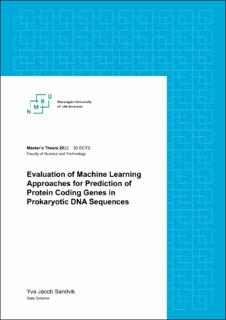| dc.description.abstract | According to the National Human Genome Research Institute the amount of genomic data generated on a yearly basis is constantly increasing. This rapid growth in genomic data has led to a subsequent surge in the demand for efficient analysis and handling of said data. Gene prediction involves identifying the areas of a DNA sequence that code for proteins, also called protein coding genes. This task falls within the scope of bioinformatics, and there has been surprisingly little development in this field of study, over the past years. Despite there being sufficient state-of-the-art gene prediction tools, there is still room for improvement in terms of efficiency and accuracy. Advances made within the field of gene prediction can, among other things, aid the medical and pharmaceutical industry, as well as impact environmental and anthropological research.
Machine learning techniques such as the Random Forest classifiers and Artificial Neural Networks (ANN) have proved successful at the task of gene prediction. In this thesis one deep learning model and two other machine learning models were tested. The first model implemented was the established Random Forest classifier. When it comes to the use of ensemble methods, such as the Random Forest classifier, feature engineering is critical for the success of such models. The exploration of different feature selection and extraction techniques underpinned its relevance. It also showed that feature importance varies greatly among genomes, and revealed possibilities that can be further explored in future work. The second model tested was the ensemble method Extreme Gradient Boosting (XGBoost), which served as a good competitor to the Random Forest classifier. Finally, a Recurrent Neural Network (RNN) was implemented. RNNs are known to be good with handling sequential data, therefore it seemed like a good candidate for gene prediction.
The 15 prokaryotic genomes used to train the models were extracted from the NCBI genome database. Each model was tasked with classifying sub-sequences of the genomes, called open reading frames (ORFs), as either protein coding ORFs, or non-coding ORFs. One challenge when preparing these datasets was that the number of protein coding ORFs was very small compared to the number of non-coding ORFs. Another problem encountered in the dataset was that protein coding ORFs in general are longer than non-coding ORFs, which can bias the models to simply classify long ORFs as protein coding, and short ORFs as non-coding. For these reasons, two datasets for each genome were created, taking each imbalance into account. The models were trained, tuned and tested on both datasets for all genomes, and a combination of genomes. The models were evaluated with regard to accuracy, precision and recall.
The results show that all three methods have potential and attained somewhat similar performance scores. Despite the fact that both time and data were limited during model development, they still yielded promising results. Considering there are several parameters that have not yet been tuned in all models, many possibilities for further research remain. The fact that a relatively simple RNN architecture performed so well, and has no requirement for feature engineering, shows great promise for further applications in gene prediction, and possibly other fields in bioinformatics. | en_US |

